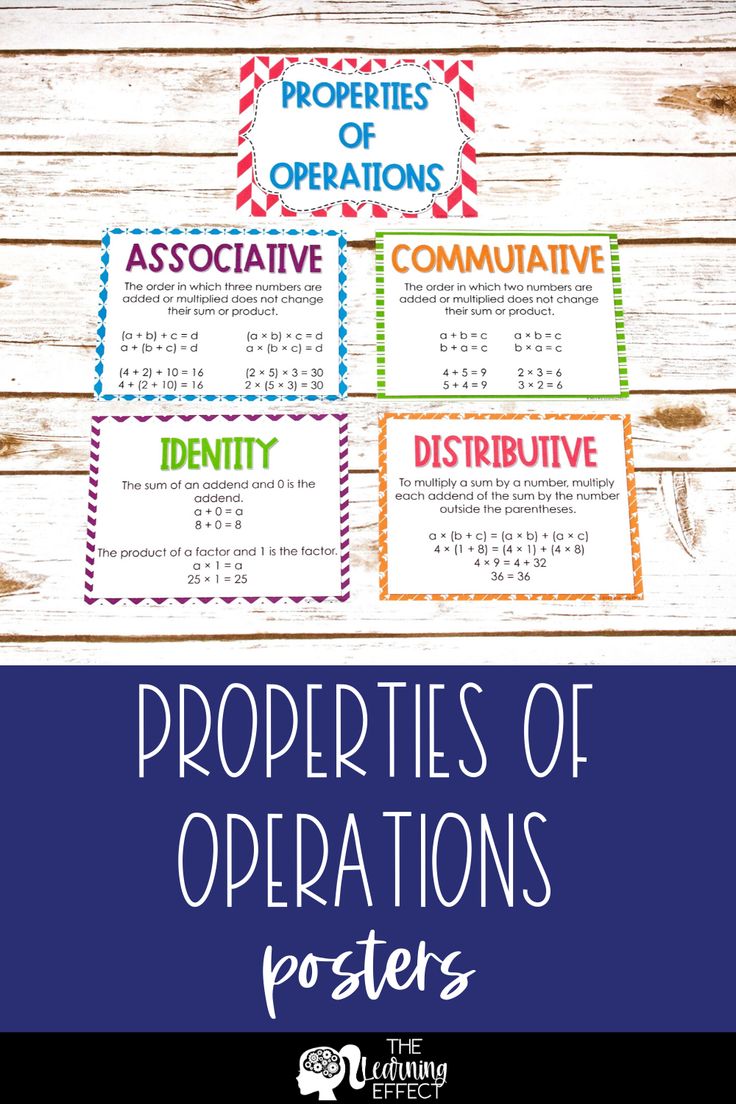5 Math Operation Properties

Mathematical operations are the backbone of arithmetic, and understanding their properties is crucial for solving equations, inequalities, and other mathematical expressions. Among these properties, five stand out due to their fundamental role in simplifying and solving mathematical expressions: the Commutative Property, the Associative Property, the Distributive Property, the Identity Property, and the Inverse Property. Each of these properties contributes uniquely to the flexibility and power of mathematical operations, allowing for the manipulation and simplification of expressions in various ways.
Commutative Property
The Commutative Property states that the order of the numbers when adding or multiplying does not change the result. This means for any numbers (a) and (b), (a + b = b + a) and (a \times b = b \times a). This property does not hold for subtraction and division, as (a - b \neq b - a) and (a \div b \neq b \div a), except when (a = b) or in specific contexts where these operations are commutative due to the nature of the numbers involved.
Example:
Given the numbers 3 and 5, we can demonstrate the commutative property of addition as follows: (3 + 5 = 5 + 3 = 8). For multiplication, (3 \times 5 = 5 \times 3 = 15).
Associative Property
The Associative Property applies to addition and multiplication, stating that when you add or multiply any three numbers, the grouping (or association) of the numbers does not affect the sum or product. Mathematically, this is represented as ((a + b) + c = a + (b + c)) for addition and ((a \times b) \times c = a \times (b \times c)) for multiplication.
Example:
For the numbers 2, 3, and 4, demonstrating the associative property of addition: ((2 + 3) + 4 = 5 + 4 = 9) and (2 + (3 + 4) = 2 + 7 = 9). For multiplication: ((2 \times 3) \times 4 = 6 \times 4 = 24) and (2 \times (3 \times 4) = 2 \times 12 = 24).
Distributive Property
The Distributive Property (or Distribution Property) is a cornerstone of algebra and arithmetic, allowing us to expand products into sums and vice versa. It states that for any numbers (a), (b), and (c), (a \times (b + c) = (a \times b) + (a \times c)) and ((b + c) \times a = (b \times a) + (c \times a)). This property significantly simplifies expressions by allowing for the distribution of multiplication over addition.
Example:
Given (a = 3), (b = 4), and (c = 5), applying the distributive property: (3 \times (4 + 5) = 3 \times 9 = 27) and ((3 \times 4) + (3 \times 5) = 12 + 15 = 27).
Identity Property
The Identity Property includes two types: the additive identity and the multiplicative identity. The additive identity states that for any number (a), (a + 0 = a), meaning that adding 0 does not change the value of (a). The multiplicative identity states that for any number (a), (a \times 1 = a), meaning that multiplying by 1 leaves (a) unchanged.
Example:
For (a = 7), demonstrating the additive identity: (7 + 0 = 7). For the multiplicative identity: (7 \times 1 = 7).
Inverse Property
The Inverse Property also consists of two parts: the additive inverse and the multiplicative inverse. The additive inverse of a number (a) is (-a), such that (a + (-a) = 0). The multiplicative inverse of a non-zero number (a) is (\frac{1}{a}), such that (a \times \frac{1}{a} = 1).
Example:
For (a = 5), the additive inverse is (-5), as (5 + (-5) = 0). The multiplicative inverse of (5) is (\frac{1}{5}), since (5 \times \frac{1}{5} = 1).
Conclusion
Understanding and applying these five properties of mathematical operations—Commutative, Associative, Distributive, Identity, and Inverse—forms the basis of arithmetic and algebra. Each property provides unique insights and tools for manipulating and solving mathematical expressions, allowing for a deeper understanding of mathematical structures and facilitating the solution of a wide range of mathematical problems. By mastering these properties, individuals can enhance their mathematical literacy and improve their ability to tackle complex mathematical challenges.
FAQs
What is the role of the commutative property in mathematics?
+The commutative property plays a crucial role in mathematics as it allows for the flexibility in the order of numbers during addition and multiplication, making it easier to solve equations and simplify expressions.
Can you explain the distributive property with an example?
+The distributive property allows us to distribute multiplication over addition. For example, (2 \times (3 + 4)) can be expanded as (2 \times 3 + 2 \times 4), which simplifies to (6 + 8 = 14). This property is essential in algebra for simplifying complex expressions.
What is the difference between additive and multiplicative inverses?
+The additive inverse of a number is the value that, when added to the original number, results in zero. For example, the additive inverse of 5 is -5, since (5 + (-5) = 0). The multiplicative inverse, on the other hand, is the value that, when multiplied by the original number, results in 1. For instance, the multiplicative inverse of 5 is (1⁄5), because (5 \times 1⁄5 = 1).
How does the associative property help in mathematical operations?
+The associative property allows for the regrouping of numbers during addition and multiplication, which facilitates the simplification of complex expressions and equations. It ensures that the order in which you perform operations does not change the result, provided the operations are either all additions or all multiplications.
What is the significance of the identity property in mathematics?
+The identity property is significant because it provides a baseline for mathematical operations. The additive identity (0) and the multiplicative identity (1) serve as reference points that do not change the value of the number they are applied to. This property is fundamental in ensuring that mathematical operations can be performed consistently and predictably.

